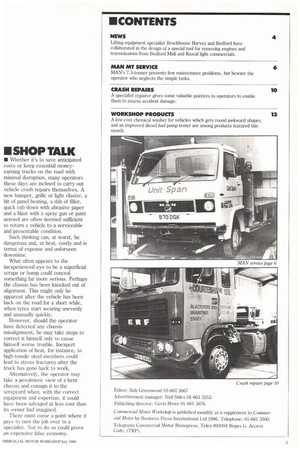II SHOP TALK
Page 103

If you've noticed an error in this article please click here to report it so we can fix it.
• Whether it's to save anticipated costs or keep essential moneyearning trucks on the road with minimal disruption, many operators these days are inclined to carry out vehicle crash repairs themselves. A new bumper, grille or light cluster, a bit of panel beating, a dab of filler, quick rub down with abrasive paper and a blast with a spray gun or paint aerosol are often deemed sufficient to return a vehicle to a serviceable and presentable condition.
Such thinking can, at worst, be dangerous and, at best, costly and in terms of expense and unforseen downtime.
What often appears to the inexperienced eye to be a superficial scrape or bump could conceal something far more serious. Perhaps the chassis has been knocked out of alignment. This might only be apparent after the vehicle has been back on the road for a short while, when tyres start wearing unevenly and unusually quickly.
However, should the operator have detected any chassis misalignment, he may take steps to correct it himself only to cause himself worse trouble. Inexpert application of heat, for instance, to high-tensile steel members could lead to stress fractures after the truck has gone back to work.
Alternatively, the operator may take a pessimistic view of a bent chassis and consign it to the scrapyard when, with the correct equipment and expertise, it could have been salvaged at less cost than its owner had imagined.
There must come a point where it pays to turn the job over to a specialist. Not to do so could prove an expensive false economy.




















































































































